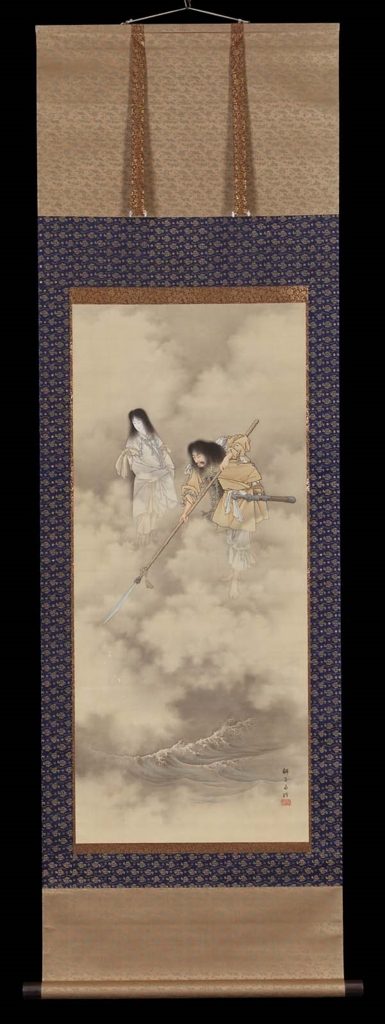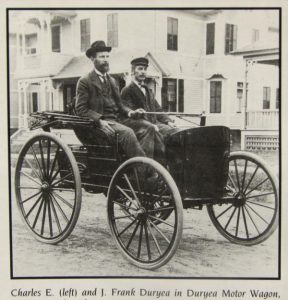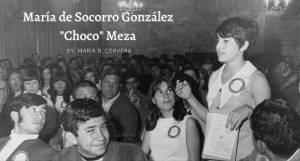The story of Izanagi and Izanami is the creation myth of the Shinto religion that is told in the Nihonshoki, Kojiki, and Kogoshui, which are “collections of oral myths” written during the eighth and ninth centuries C.E.1 The myth begins with “something light and transparent” rising up from a sea of “boundless, shapeless” chaos and becoming the Plain of High Heaven.2

Then the Three Creating Deities spring forth from the Plain: Ame-no-Minaka-Nushi-no-Mikoto, Takami-Musubi-no-Mikoto, and Kammi-Misubi-no-Mikoto.3 Meanwhile, the sea of chaos had become the earth, but the land floated “resembling oil” on the water. Then, the gods Umashi-Ashi-Kahibi-Hikoji-no-Mikoto and Ame-no-Tokotachi-no-Mikoto spring forth from the land. After this, many other gods were born until one day, a pair of gods named Izanagi and Izanami were given a spear decorated with jewels by the other gods and told to create solid land, as these gods did not have anything to do.3
Izanagi and Izanami then stood on Ama-no-hashidate, the “bridge or stairway of heaven.”5 They were initially confused as to how they were supposed to create solid land until Izanagi proposed that they stick the spear into the water and stir it around. Izanagi then stuck the spear into water, hit something, and noticed that the substance that dripped from the spear when he took it out became the island of Onogoro.6 Izanami and Izanagi then built a home on Onogoro and conducted a marriage ritual that involved them circling around a pillar, Izanami traveling in one direction and Izanagi traveling in the other direction. The first time they did this, Izanami was the first to greet Izanagi when they met.7 Despite Izanagi’s belief that Izanami should not have spoken first, they conceived a child.8
Unfortunately, their first child, the god Hiruko, was born deformed and boneless, so Izanagi and Izanami put Hiruko in a boat and abandoned him to the sea. Izanami then gave birth to the island of Awa, but the couple were still unhappy with their children, so they decided to ask the other gods what to do.9 The other gods told the couple that Izanagi was supposed to greet Izanami during their marriage ritual, not the other way around. Izanagi and Izanami then performed the marriage ritual correctly and from that point forward were pleased with their children, who included the “eight principal islands of Japan.”10
Izanami and Izanagi then gave birth to many other gods. Unfortunately, their happiness would not last. While Izanami was giving birth to the fire god Kagutsuchi, she suffered painful burns and, despite Izanagi’s attempts to save her life, died from her burns.11 Izanagi was devastated by his wife’s death and, in his rage, decapitated Kagutsuchi with his sword. Many deities were spawned from Kagutsuchi’s blood and corpse.12
Heartbroken and desperate to see his wife again, Izanagi decided to go down into Yomi-tsu-kuni, the underworld, and bring Izanami back to life. Unfortunately, Izanami was unable to leave the underworld as she had already eaten its food.13 Izanami decided to appeal to the gods of the underworld to allow her to return to life, but she made Izanagi promise to wait for her and told him not to try to see her or “look inside the castle” of the underworld until she came back. Izanagi agreed, but he quickly became anxious to see Izanami. Eventually the wait proved too much for Izanagi, so he lit part of a comb that he had with him on fire and attempted to see Izanami.14 However, he soon found out firsthand why Izanami did not want him to see her. Izanami’s body was rotting away and “eight Thunder-Deities” were “dwelling there” within her body. The very sight of it caused Izanagi to flee in fear, which along with the fact that he broke his promise, angered Izanami.15 She swore to make him “suffer for his perfidy” and ordered “an army of female demons to chase him out of the underworld.”16 During Izanagi’s escape, he threw his stick down, which created the two gods of the road, and pushed a boulder into the entrance of the underworld so that he could safely get away.17 Afterwards, while bathing in the river Woto in order to clean “the impurities of the underworld” off of him, multiple other gods were created when he took off his clothes and washed various parts of his body. This is why followers of Shintoism purify themselves before entering shrines.17 Izanami and Izanagi are commemorated in the “wedded rocks of Meotoiwa.” The “wedded rocks of Meotoiwa” are a pair of rocks representing Izanagi and Izanami that are linked by a “sacred long rope” representing their marriage.17
- Mark Cartwright, “Izanami and Izanagi,” Ancient History Encyclopedia, last modified December 06, 2012, http://www.ancient.eu /Izanami_and_Izanagi/. ↵
- Genji Shibukawa, “Japanese Creation Myth,” in Reading about the World, Volume 1, trans. Yachiro Isobe, n.d. ↵
- Genji Shibukawa, “Japanese Creation Myth.” ↵
- Genji Shibukawa, “Japanese Creation Myth.” ↵
- Mark Cartwright, “Izanami and Izanagi,” Ancient History Encyclopedia. ↵
- Mark Cartwright, “Izanami and Izanagi,” Ancient History Encyclopedia. ↵
- Mark Cartwright, “Izanami and Izanagi,” Ancient History Encyclopedia. ↵
- Genji Shibukawa, “Japanese Creation Myth.” ↵
- Mark Cartwright, “Izanami and Izanagi,” Ancient History Encyclopedia. ↵
- Mark Cartwright, “Izanami and Izanagi,” Ancient History Encyclopedia. ↵
- Genji Shibukawa, “Japanese Creation Myth.” ↵
- Genji Shibukawa, “Japanese Creation Myth.” ↵
- Mark Cartwright, “Izanami and Izanagi,” Ancient History Encyclopedia. ↵
- Genji Shibukawa, “Japanese Creation Myth.” ↵
- Genji Shibukawa, “Japanese Creation Myth.” ↵
- Genji Shibukawa, “Japanese Creation Myth.” ↵
- Mark Cartwright, “Izanami and Izanagi,” Ancient History Encyclopedia. ↵
- Mark Cartwright, “Izanami and Izanagi,” Ancient History Encyclopedia. ↵
- Mark Cartwright, “Izanami and Izanagi,” Ancient History Encyclopedia. ↵



29 comments
Christian Lozano
An incredible creation myth indeed, much like Life and Death, and events like the Big Bang, Destruction is a form of Creation, an idea which is very well presented in this article. Great Job!
Jacob Hall
Wow, I never thought about how the Asian cultures might have gods, I always thought they worshiped the spirits of their ancestors. that being said I find the story of Izanagi and Izanami to be beautiful, and tragically romantic. the level of detail and thought that went into the deities was amazing, i love how they can be born from things like baths or dropping a stick.
Maalik Stansbury
There was a lot of information put into this article, and well presented. I thought it was interesting how Izanami sent her Demon females” which makes me think of sirens and mermaids. But i really did enjoy the style of how you wrote the article, very descriptive and attention grabber. Excellent job
Rafael Ortiz Salas
I didn’t know about the Shinto religion or Japanese Gods. It was interesting to learn about their mythology, and that all of their gods were created by the marriage of Izanami and Izanagi. Your article was very informative and well researched, I really enjoyed learning about the Shinto Religion. Good Job! 🙂
Ivanna Rodriguez
Your article was fascinating! I had never known about the creation of the Shinto religion. It was extremely interesting to find out about all the gods that were created through the marriage of Izanami and Izanagi. Also,their marriage was incredibly fascinating due to the fact that in the end, Izanami unleashed her wrath on Izanagi. The saying, “Hell hath no fury like a woman scorned” is very accurate for their marriage. Incredibly well-researched and detailed. Great work!
Andres Palacios
I never read about the Japanese mythology until know. It is very interesting how Inzanagi and Inzanami gave birth to plenty of other gods specially the god of fire who caused Inzanami’s death.
Rachel White
This article was very informative and highly interesting because many religions know the stories of the Earth that their religion believes, but not that of other religions. Your article gave insight into the Shinto religion and not only how the earth was formed, but also with how beautifully elaborate their stories are. Very good topic to chose and explore and a great list of sources that you used. I hope to see more work like this from you in the future.
Analina Devora
This article really grabbed my attention. You not only described a myth but told a very beautiful yet brutal story about these two gods. My favorite part was when Izanami sent her “female demons” on Izanagi, I actually found it slightly humorous. I really loved this article, can’t wait for your next one.
Mehmet Samuk
We always read about the Greek mythology or the Egyptian gods but I never heard about the Japanese gods. It was interesting to read about them and learn their mythology as well. I liked the article but the repetition of similar God names was a little confusing maybe because of the lack of background information for me.